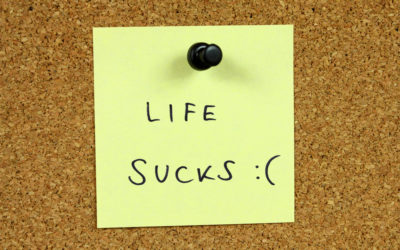By the end of the second day, somewhat exasperated, I said to him:
“I can tell you right now I see the possibility of a bright future for you, and I know for a fact you could be enjoying your life right now, today, in this moment regardless of what’s going on. And you’d better hope that I’m right and you’re wrong. Because if you’re right, you’re screwed; if I’m right, at least there’s the possibility of better times ahead.”
Surprised and a bit taken aback by my outburst, he asked me what I thought he should do:
“You’re going to have to find a way to shut the hell up in your mind”, I said, “and listen for something new – something you don’t already think and something you don’t already ‘know’. If you do, I promise you you’ll hear something that will change this for you.”
To his credit, he did, and he was like a different person by the time he left at the end of the next day. His only complaint was that I hadn’t told him to “shut up” earlier so we wouldn’t have wasted so much air time replaying the sound bites and tape loops he’d been running in his head over the first two days.
Now, you may be aware that we’ve had a presidential election here in the United States recently. As happens every four years, one person won and the other person lost. People who supported the one who won are generally feeling pretty good, as they’re thinking lots of thoughts about how wonderful things are going to be in the future and feeling those thoughts as if they’re happening now.
Similarly, many of the people who supported the one who lost are feeling pretty bad, as they’re thinking lots of thoughts about how horrible things are going to be in the future and feeling those thoughts as if they’re happening now.
That’s just how the mind works – we live in the feeling of our “right now” thinking, moment by moment by moment. To the extent that we know that, it gives us a bit of space around it – we don’t have to take it to heart and project it out into the future. To the extent that it looks to us like our feelings are coming from the outside world, we’re stuck in them – and it not only looks bad now, it looks like it’s always been bad and it will only get worse.
One of my students recently shared the analogy of waking up with a terrible hangover. If she hadn’t understood the nature of hangovers, she would have genuinely thought she was dying. She might have taken the time to get her affairs in order, done her best to make peace with her unresolved conflicts, and called an ambulance to take her to the hospital. But because she knows how hangovers work, she took a couple of aspirin, promised herself that she would never drink that much again (with her fingers crossed behind her back, obviously), and got on with her day, knowing that hangovers go away all by themselves as the amazing self-correcting mechanism of the body brings itself back to a healthy equilibrium.
Similarly, if we understand the nature of the mind, we know that when we feel miserable, bleak, and hopeless, it’s because we’re caught up in some miserable, bleak, and hopeless thinking. And we also know that the moment we put that thinking to one side, the amazing self-correcting mechanism of the mind will bring us some fresh new thinking and creative, hopeful possibilities as it restores itself once more to a healthy equilibrium.
But how do we do it? How do we put down our thinking when everything in us is telling us we need to take things more seriously, not less? How do we allow our natural buoyancy and resilience to come to the surface when the problem seems so much more deeply rooted than something as frivolous as “thought in the moment”?
I can only share what I’ve seen for myself that helps me – hopefully you’ll find something in it that triggers your own natural capacity for insight, creativity, and realization…
1. Stop saying “it’s just a thought”
In 2013, I decided to take a year off from running Supercoach Academy until I could find a better way of sharing the three principles at the heart of my work. I had noticed the most frequent thing I heard students and clients saying was “I know it’s just a thought, but…” and then finishing the sentence with things that indicated their problem was nothing to do with their thinking and everything to do with their past, future, and the world around them.
If you’ve ever wanted to smack someone who’s come up to you in the midst of a personal crisis and told you “it’s just your thinking”, you know that the brilliance of the thought/feeling system is that temporary and illusory though our thoughts may be, the feelings we feel in response to them are 100% real in the body. We FEEL our thinking, and those feelings are not illusory and almost never feel temporary.
Here’s the thing:
Saying “it’s just a thought” is like saying “it’s just nuclear energy”. Thought is the most powerful force in the universe, and while it can do a tremendous amount of good when handled with care and respect, it can destroy the world when misused or misunderstood.
The strength of your feeling isn’t telling you that “this one couldn’t possibly be made of thought” – it’s giving you an indication of just how powerful thought really is. And when you see that the ONLY source of your feeling is thought in the moment – not the remembered past, not the imagined future, not even the recent election results – the self-correcting mechanism of the mind kicks into action and your thoughts begin to change for the better.
2. See the disconnect between feeling bad and doing good
Martin Luther King had a dream. Mother Teresa had a mission. Nelson Mandela had a vision. While their movements were forged in a cauldron of social inequality and unrest, their personal stories are filled with examples of their love for humanity and their hope for a positive future.
One of the reasons that people think they need to feel bad in order to make a change is that so often, our dreams and visions for a positive future come to us at seeming low points in our lives. We’ve been almost forced to go inside and take stock – to find out what we know to be true underneath the constant noise of our habitual thinking. This deeper knowing never comes with feelings of anger or fear. It carries with it a feeling of resolve, and of hope, and of love, and of peace. We may not know how things are going to change but we know we will be an agent of that change.
As George Bernard Shaw said:
“This is the true joy in life, the being used for a purpose recognized by yourself as a mighty one; the being a force of nature instead of a feverish, selfish little clod of ailments and grievances complaining that the world will not devote itself to making you happy.”
You don’t need to stay angry to make a difference – in fact, it’s one of the least efficient ways of doing so. Anger may get people to gather in the street, but it’s inspiration that gets them to march forward instead of mobbing up and destroying whatever they see around them.
Where does that inspiration come from?
It comes from deep inside you, and it comes through in the moments that your constant thinking about how the world needs to change pauses. You find a little sliver of quiet – a space between thoughts – and through that space your path begins to emerge.
As Marianne Williamson said:
“God heard us. He sent help. He sent you.”
3. Open your mind to new possibilities
Have you ever wondered how it’s possible that seemingly intelligent people disagree with you?
One explanation is that they’re just a bit confused, and when they come to their senses, they’ll agree with you. Another is that they’re not as intelligent as you thought they were. A third, and in my mind more accurate explanation, is that we all live in separate realities.
We think the mind works like a camera, accurately recording what’s really going on around it, but in actuality, the mind works more like a projector. It projects our thoughts onto the screen of our consciousness, and then we experience that created world through our senses.
That’s why nearly everyone who looks at this image sees an upside down white triangle bold in the middle:

In truth, there are no triangles or circles at all in the image – just a series of lines and shapes on a field of white space. Our minds fill in that space, projecting an illusory upside down triangle on top of three made up circles and a “right-side up” triangle that everyone can see but only exists in our imagination.
Here’s how I write about it The Inside-Out Revolution:
As you walk around the studio, you notice small and sometimes vast discrepancies between what people are painting on their canvases. Arguments break out in parts of the room as to whether or not the model for the painting is more one color than another, taller or shorter, uglier or more beautiful than rendered.
You begin to become curious about what it is that everyone’s painting, so you make your way to the center of the room and discover to your surprise that there’s absolutely nothing there. The emptiness of the center is palpable.
Suddenly you realize the reason why everyone’s painting a different picture isn’t down to their point of view, where their easel happens to be placed, or even to a matter of personal interpretation. It’s because what they are ‘viewing’ is only a projection of their own thoughts.
Which is why someone can apparently look at the same things we’re looking at and come to different conclusions. We’re not actually looking at the same thing. They’re looking at their own created reality; we’re looking at ours. We’re both absolutely right given what we see, and our perception of what’s going on is absolutely limited. As the theosopher Syd Banks said “Everyone is doing the best they can, given the thinking they have that looks real to them.”
You can’t change someone’s mind without first opening up your own. What do they see that you don’t? What babies of wisdom and truth are you throwing out in the bathwater of their rhetoric?
We can absolutely learn from one another – we can partner in creating a better world by striving to see what others see. I spoke about this in a recent podcast called How to Become More Intelligent, Beginning Today. I shared what I consider to be a master strategy for increasing your intelligence and becoming more influential with others:
Find someone you recognize to not be a complete moron who disagrees with you and really listen to them.
Don’t worry about all the people who disagree with you because of their ignorance or hidden agendas. They’re out there too. Don’t worry about getting your point of view across. You’ll be able to do that more powerfully once you recognize that it’s just a point of view. Find one person who might see something you don’t and learn what you can learn from them. Repeat as often as you can. Be the change you wish to see in the world.
With all my love and every blessing,
![]()










